Farmer's Welfare
Shree Anna for Shreshta Bharat
Empowering India through Millets
Posted On: 08 AUG 2025 9:35AM
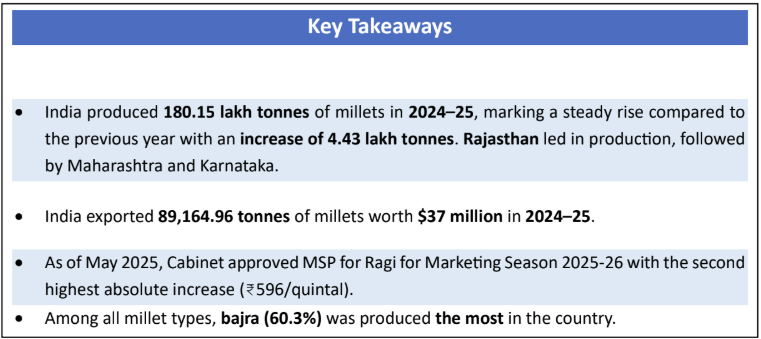
Introduction
Guddu Dongare, a farmer from Betul district in Madhya Pradesh is inspiring a quiet revolution — one millet seed at a time. Once faced with an unproductive patch of fallow land, Guddu’s fortune took a turn after he attended a farmer field school organised by the local agriculture department. It was here that he first heard about millets. He learnt that millets can withstand changing weather conditions, need fewer inputs, grow in a shorter period, and adapt well to nearly all types of soils.
Armed with this new knowledge and support from the Rashtriya Krishi Vikas Yojana (RKVY), Guddu decided to experiment. He chose to grow Kodo (Kutki) millets on one hectare of his fallow land. With the guidance of field officers, he adopted modern techniques like row farming. The change was visible within weeks.
Guddu’s harvest yielded 12 quintals of Kodo millet. After selling his produce, he earned a profit of ₹10,000 from just one hectare. More than the income, it was the confidence that came with it.
The regular visits by agriculture officers became more than technical guidance. They gave him courage to keep experimenting, taught him how to use organic manure, and showed him how millets could be a long-term solution — for both the farm and the farmer.
His success has drawn attention in the village. Local farmers are now considering millet cultivation on underutilised or less productive land. Many are also becoming aware of the health benefits of millets, besides their economic potential.
Guddu’s example demonstrates how informed support and sustainable practices can bring real improvement, even from land once considered unviable.
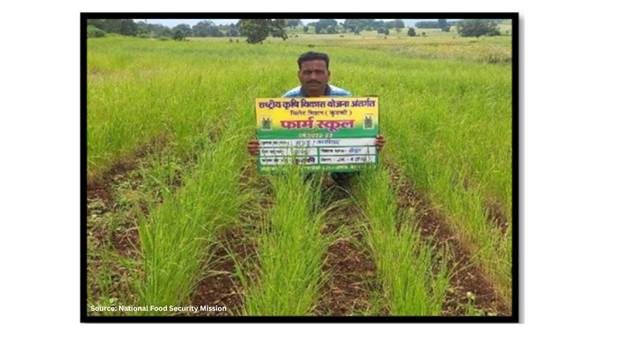

Millets, popularly known as Shree Anna, are a group of small-grained cereals valued for their exceptional nutrition and adaptability. At India’s request, the United Nations General Assembly declared 2023 as the International Year of Millets, recognising their importance for food and nutritional security. Millets are rich in protein, vitamins and minerals and are naturally gluten free. They have a low glycaemic index, making them suitable for people with diabetes and celiac disease. Their nutritional quality makes them superior to wheat and rice, earning them the name “nutritious cereals”.
India is currently the largest producer of millets in the world, contributing 38.4% of global production (FAO, 2023). Their ability to grow with minimal inputs and withstand climatic variations has made them a sustainable choice for farmers and an important part of the nation’s food basket. As of July 2025, India has achieved a total millet production of 180.15 lakh tonnes in 2024–25, which is 4.43 lakh tonnes higher than the previous year. This steady rise reflects the country’s focused efforts to promote millet cultivation across diverse agro-climatic regions.
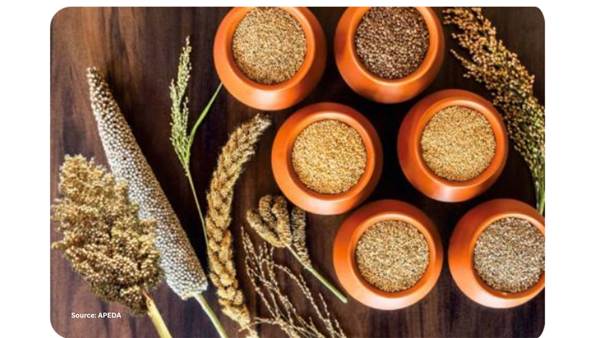

Budgetary and Policy Support
Bottom of FormThe Government of India has consistently strengthened the budgetary and policy framework for promoting millets, now popularly known as Shree Anna. These allocations cut across the entire value chain, from cultivation to processing, exports and research.
1. Support for Cultivation
Millet cultivation is supported through the National Food Security and Nutrition Mission (NFSNM), formerly known as National Food Security Mission (NFSM).
National Food Security Mission – Nutri Cereals
To boost the production of millets, the Department of Agriculture and Farmers Welfare is running a Sub-Mission on Nutri-Cereals comprising sorghum (Jowar), pearl millet (Bajra), finger millet (Ragi/Mandua) and small millets viz; little millet (Kutki), kodo millet (Kodo), barnyard millet (Sawa/Jhangora), foxtail millet (Kangni/Kakun), proso millet (Cheena) under the National Food Security Mission. This initiative covers 28 States and two Union Territories, namely Jammu and Kashmir and Ladakh.
The Government of India also allows states to use the Pradhan Mantri Rashtriya Krishi Vikas Yojana (PM RKVY) according to their own needs and priorities. States can promote coarse cereals and millets, known as Shree Anna, under this scheme with the approval of the State Level Sanctioning Committee. This committee is to be chaired by the Chief Secretary of the state.
Under the Nutri-Cereals Sub-Mission, farmers receive support through their respective State or Union Territory. The assistance includes cluster demonstrations to showcase improved farming practices, production and distribution of seeds of high-yielding varieties and hybrids, and the use of modern farm machinery and resource conservation tools. Farmers are also supported with efficient water-use equipment, plant protection measures, soil health inputs, and training on different cropping systems.
The umbrella allocation for this mission is part of the Krishionnati Yojana which has a financial outlay of ₹8,000 crore for 2025–26.
Farmers also receive assistance through the Pradhan Mantri Rashtriya Krishi Vikas Yojana (PM RKVY), which encourages crop diversification and has a budget of ₹8,500 crore for 2025–26.
2. Processing and value chain support
a) PM Formalisation of Micro Food Processing Enterprises (PM‑FME)
The Pradhan Mantri Formalisation of Micro Food Processing Enterprises (PM–FME) scheme provides targeted support to micro food processing units, including those dealing with millet-based products.
The scheme has an allocation of ₹2,000 crore for 2025–26.
b) Production Linked Incentive for Millet‑Based Products (PLISMBP)
Production Linked Incentive Scheme for Millet-Based Products (PLISMBP) was introduced to encourage-
- The use of millets in branded Ready‑to‑Eat (RTE) and Ready‑to‑Cook (RTC) products.
- To encourage value addition in millet-based food items by supporting their manufacture for both domestic and export markets.
- To connect millet growers with food processors by boosting production demand for the grain.
Scheme Components
- Incentive linked to sales growth: Participants must achieve at least 10% year-on-year sales growth of eligible millet-based products over the base year.
- Eligible products must contain at least 15% millet by weight or volume and must be branded in consumer packs. Only domestically sourced millets are accepted—excluding additives, oils or flavours.
The scheme has an outlay of ₹800 crores, carved out of the larger Production Linked Incentive Scheme for Food Processing Industry (PLISFPI) fund. Out of this, an amount of ₹793.27 crore has been approved to support 29 companies, which include 8 large and 21 small & medium-scale units. Objective is to promote the establishment of millet processing units and increase their presence in both domestic and global markets.
3. Export Promotion and Marketing
Export promotion for millets is led by the Agricultural and Processed Food Products Export Development Authority (APEDA) under the Department of Commerce. APEDA has a specific mandate to develop markets for Indian millets abroad.
Export of processed food products has increased from 5 billion dollars to 11 billion dollars in last 11 years.
The authority has been allocated ₹80 crore in 2025–26.
The Government has been working to leverage partnerships with start-ups, academic & research institutions, Indian missions, processors, retailers and exporters to promote Indian millets in the global markets. An Export Promotion Forum (EPF) has been set up to boost the global presence of Indian millets. It works to connect stakeholders and promote exports through targeted outreach. A dedicated online portal has also been developed. It provides detailed information on different types of millets, their health benefits, production trends and export statistics. The portal also features a directory of registered millet exporters to support trade and connect buyers with suppliers.
4. Research and development
The Department of Agricultural Research and Education (DARE) and The Indian Council of Agricultural Research (ICAR) continue to work on the development of improved millet varieties.
The ICAR–Indian Institute of Millets Research (IIMR), Hyderabad, is the nodal agency for millet research in India under the Indian Council of Agricultural Research (ICAR). Recognised as the Global Centre of Excellence on Millets during the International Year of Millets 2023, it leads efforts to improve millet cultivation and awareness.
IIMR focuses on developing high-yielding millet seeds and provides hands-on training to small and marginal farmers on improved farming methods, value addition, and health benefits. It supports the formation of millet-based Farmer Producer Organisations (FPOs) to boost farmer incomes and expand millet cultivation.
As a knowledge partner, IIMR collaborates with state missions and agriculture departments in Odisha, Karnataka, Jharkhand, Tamil Nadu, Telangana and Chhattisgarh etc. These partnerships aim to promote millets as climate-resilient crops and build public awareness about their nutritional value.
5. Public distribution and procurement
Millets have also been integrated into the public procurement system. The Pradhan Mantri Garib Kalyan Anna Yojana (PM–GKAY) and the National Food Security Act provide for the procurement and distribution of coarse grains, including millets.
Coarse grains and millets can also be provided under the Public Distribution System in place of the same quantity of wheat or rice if a state makes such a request. The total quantity of rice, wheat and coarse grains supplied must, however, remain within the maximum limit set for each state or union territory.
The Outcome Budget 2025–26 shows a total allocation of ₹2,03,000 crore for PM–GKAY.
Production of Millets
India produced a total of 180.15 lakh tonnes of millets in 2024–25. This was an increase of 4.43 lakh tonnes compared to the previous year.
State-wise Production of Millets
Rajasthan produced the highest quantity of millets in 2024–25. It was followed by Maharashtra in the second position and Karnataka in the third position.
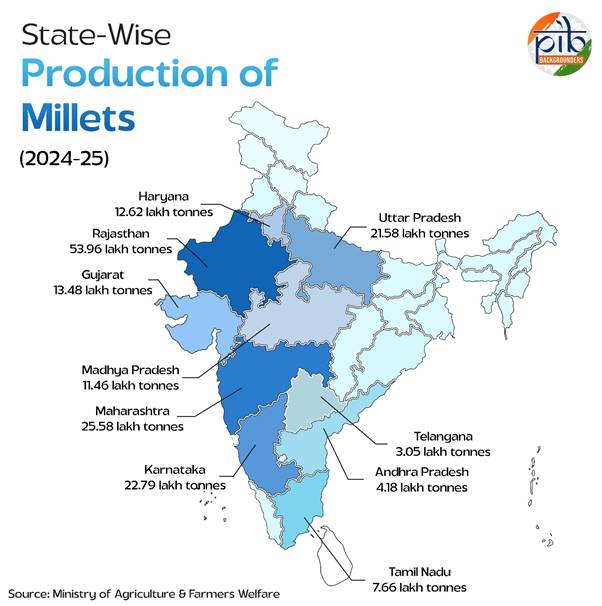
Crop-wise Production of Millets
Among all millet types, bajra was produced the most in the country. It contributed the largest share to the overall millet production, followed by jowar, ragi and small millets.
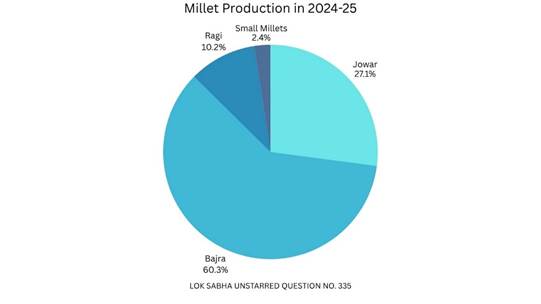

India’s Export of Millets
In 2024–25, India exported a total of 89,164.96 tonnes of millets. The total value of these exports stood at 37 million USD.
Leading Efforts by States and UTs to Promote Millets in Daily Diets
Andhra Pradesh – Drought Mitigation Project (APDMP)
Supported by (International Fund for Agricultural development) IFAD and Government of Andhra Pradesh in collaboration with local agriculture agencies to focus on problem of repeated drought, thus effecting the productivity of agriculture.
Through established Farmer Producer Organizations (FPO’s), the project is promoting minor millet varieties like foxtail, little, barnyard, kodo, brown top millets etc.
Innovations included development of millet-based recipes like rotis, biscuits, paayasam (kheer), chikkis, laddus, jantikalu etc. using foxtail and brown top millet.
Chhattisgarh – Millet Mission
Government of Chattisgarh launched this mission in 2021 to become the heart of millet cultivation.
Emphasis on MoU with ICAR-IIMR to improve productivity of Kodo, Kutki, and Ragi.
Strong push for tribal inclusion, decentralised processing and FPO development.
Haryana – Bhavantar Bharpayee Yojana
- The Bhavantar Bharpayee Yojana is a price compensation scheme of the Haryana Government.
- The difference between MSP and average market price is known as the ‘Bhavantar’ price.
- Only farmers registered on the ‘Meri Fasal, Mera Byora’ portal are eligible for benefits.
- It was initially launched to support horticulture farmers during market price crashes.
- The scheme helps reduce the financial risk of farmers by ensuring a minimum return.
- It also aims to promote crop diversification across the state.
Extension to Bajra
- From the Kharif season of 2021, bajra was included under the scheme.
- Haryana became the first state in the country to extend price protection to a millet crop through BBY.
- If private buyers offer a lower price, the Government compensates the farmer up to ₹600 per quintal.
- The payout is based on average yield and post-verification of crop records.
Odisha Millet Mission (OMM)
The Government of Odisha launched the Odisha Millet Mission in 2017. It was started as a special initiative to revive millets, especially ragi, in tribal areas. The programme aims to bring millets back to farms and households while focusing on all stages of the value chain. This includes growing, processing, consuming, marketing and linking millets with government food schemes. Key features include conditional cash transfers to farmers, Ragi laddoo included in Anganwadi centres benefitting preschool children, and Millet Shakti Cafés serving lakhs of people.
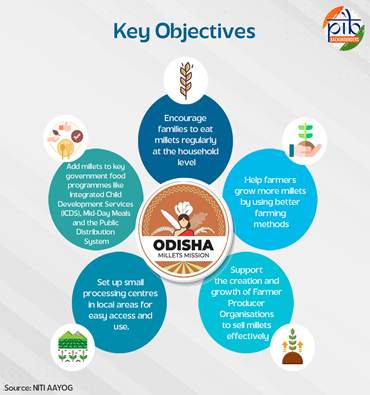
Implementation Model
- The programme is implemented directly by FPOs.
- Local NGOs help with field-level planning and capacity building.
- District and block-level line departments monitor and guide the mission’s progress.
Establishment of millet processing units in Odisha
As of February 2025, In Odisha, millet-based products have been identified as the One District One Product (ODOP) in two districts—Malkangiri and Nuapada. Additionally, incubation centres focused on millet processing have also been sanctioned. So far, 17 millet-based incubation centres have been approved across the country under the PM Formalisation of Micro Food Processing Enterprises (PMFME) Scheme.
Under the same scheme, loans worth ₹1.44 crore have been sanctioned to 21 entrepreneurs in Odisha to set up millet-based processing units. Across the country, loans totalling ₹173.24 crore have been sanctioned to over 3300 such entrepreneurs.Top of FormBottom of Form
Nagaland – Nutri-Cereals under NFSM
- Foxtail millet formally included under the state’s NFSM initiatives.
- Activities involved seed distribution, integrated nutrient and pest management and training.
- Aimed to boost area, productivity and traditional consumption.
Millets Mainstreaming Framework
- The millets mainstreaming framework focuses on six key areas of the value chain. These include production, storage and transport, processing, packaging and branding, distribution, and consumption.
- In production, efforts are made to train farmers in better farming methods. Support is also given for seeds, tools, irrigation, and agricultural research.
- For storage and transport, work is being done to improve storage facilities, manage post-harvest handling, and reduce losses during movement of produce.
- Processing includes harvesting, cleaning, grading, and spreading new technologies. There is special focus on handling small millets, which are often overlooked.
- In packaging and branding, support is given for nutrition labelling, organic certification, and brand creation. FPOs and farmer groups are guided to help them earn better prices.
- Distribution efforts include helping farmer groups come together, find markets, and connect with buyers. Export support is also part of this area.
- To increase consumption, awareness campaigns have been launched. Small businesses and mobile kiosks are being encouraged to sell millet-based products in local markets.
- These activities rest on five strong foundations. These are institutional support, access to finance, partnerships, a helpful policy environment, and gender inclusion.
To increase visibility, a Millets Experience Centre has been set up at Dilli Haat in Delhi. Government offices have also been advised to include millet-based snacks and meals in their meetings, events, and canteens.
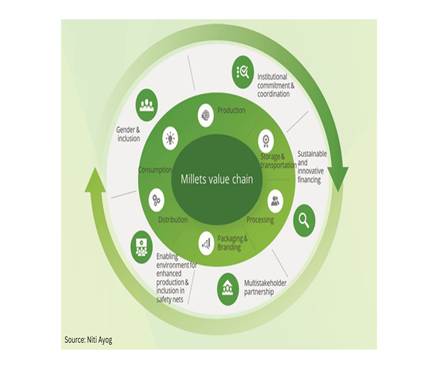
Conclusion
Millets, or Shree Anna, hold the promise of a healthier, more resilient, and sustainable future. With their rich nutritional profile and climate-smart qualities, they offer a practical solution to many challenges faced by Indian agriculture today. The collective efforts of central ministries, state governments, research bodies, farmer organisations, and private players are helping restore millets to their rightful place in farms, markets, and diets.
From enhanced production and value addition to focused promotion and global outreach, India is setting a strong example in millet mainstreaming. The momentum built during the International Year of Millets and beyond must now translate into lasting change—making millets a daily part of India’s food culture and economy.
References:
National Food Security Mission
nfsm.gov.in/Success_Stories/Success_Stories_Millets.pdf
PM India
https://www.pmindia.gov.in/en/news_updates/pms-address-in-the-123rd-episode-of-mann-ki-baat/
Lok Sabha Question
https://sansad.in/getFile/loksabhaquestions/annex/185/AU335_11GYcE.pdf?source=pqals
Rajya Sabha Question
https://sansad.in/getFile/annex/267/AU3218_cpdO2d.pdf?source=pqars
https://www.mofpi.gov.in/sites/default/files/58.pdf
APEDA
https://apeda.gov.in/IndianMillets
https://www.commerce.gov.in/press-releases/apeda-strategizes-action-plan-for-the-promotion-of-millets-and-millet-products-with-iimr/
Nutri-Cereals
https://nutricereals.dac.gov.in/
India Budget
https://www.indiabudget.gov.in/doc/OutcomeBudgetE2025_2026.pdf
https://www.indiabudget.gov.in/doc/eb/sbe10.pdf
PIB Press Release
https://static.pib.gov.in/WriteReadData/specificdocs/documents/2024/feb/doc2024216311701.pdf
https://www.pib.gov.in/PressReleasePage.aspx?PRID=2114891
https://www.pib.gov.in/PressReleaseIframePage.aspx?PRID=1947884
https://www.pib.gov.in/PressReleasePage.aspx?PRID=2082229
https://www.pib.gov.in/PressReleasePage.aspx?PRID=2115780
https://www.pib.gov.in/PressReleasePage.aspx?PRID=2003546
https://www.pib.gov.in/PressReleasePage.aspx?PRID=2131983
NITI Ayog
Report-on-Promoting-Best-practices-on-Millet-26_4_23.pdf
Millets-Mainstreaming-FrameworkEnglish15072022.pdf
Shree Anna for Shreshta Bharat
*****
SK/SM
(Backgrounder ID: 154991)
Visitor Counter : 16
Read this release in:
Hindi